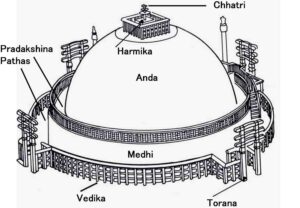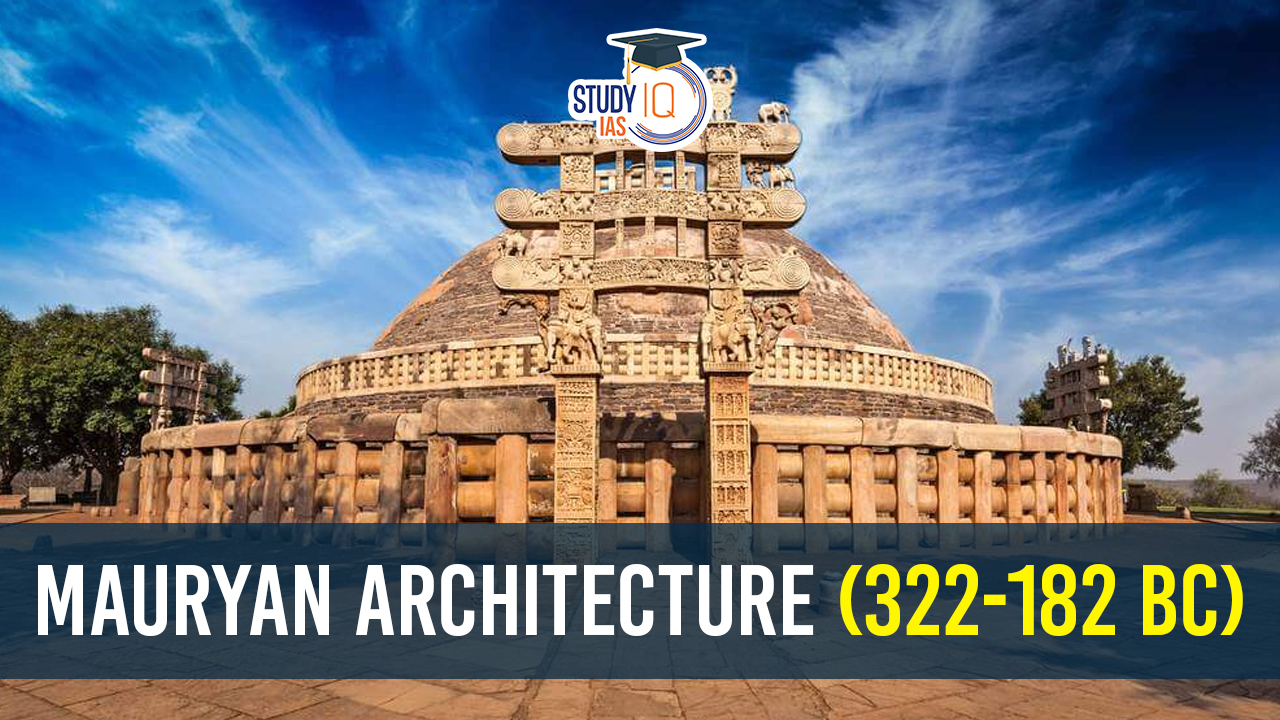Table of Contents
The Mauryan Empire, thriving from the 4th to 2nd centuries BC (322 BC to 182 BC), made a profound impact on Indian history through its artistic and architectural achievements. Notably, Mauryan Architecture of sandstone pillars, featuring inscriptions of Emperor Ashoka’s edicts, became iconic symbols. Stupas, grand dome-shaped Buddhist shrines, showcased the Empire’s architectural prowess, while viharas, housing Buddhist monks, reflected a commitment to religious support. Mauryan artistic expression, marked by stone carving, reached new heights during this period, contributing to the era’s aesthetic appeal and leaving a lasting legacy in Indian cultural history.
Mauryan Architecture Background
Founded by Chandragupta Maurya in 321 BC, the Mauryan Empire marked a significant era in Indian history. Following the decline of stone structures between the Harappan and Mauryan periods, a cultural renaissance unfolded during Mauryan rule.
This period witnessed the prominence of monumental stone sculpture and architecture, reaching its zenith under Ashoka’s reign. The emphasis shifted to court art, with Ashoka’s adoption of Buddhism influencing distinctive sculptural and architectural styles. Stupas, Pillars, Caves, Palaces, and Potteries emerged as expressions intertwined with the lives and patronage of ordinary people.
Features of Mauryan Architecture
- Wooden Construction: Predominantly built with wood, both Chandragupta Maurya and Ashoka’s palaces exemplified Mauryan architecture.
- Kumrahar Significance: Kumrahar in Patna showcased notable Mauryan palaces, featuring intricate carvings and designs.
- Multifunctional Palaces: Used for governance, administration, and hosting guests, Mauryan palaces served diverse purposes.
- Lost Structures: While some palaces succumbed to time, remaining ones at Kumrahar offer glimpses into the empire’s grandeur.
- Opulence and Wealth: Reflecting the empire’s prosperity, Mauryan palaces demonstrated opulence through their design and construction.
- Architectural Diversity: From wooden palaces to rock-cut caves, Mauryan architecture exhibited versatility and adaptation to different terrains.
- Historical Insights: The surviving structures provide valuable insights into ancient Indian architecture, design, and cultural practices.
- Cultural Significance: Mauryan architecture reflects the cultural richness and administrative acumen of the Mauryan Empire.
Classification of Mauryan Architecture
Mauryan architecture can be classified into several distinct categories, each representing different aspects of the architectural achievements during the Mauryan Empire:
| Category | Description | Examples |
| Stupas | Dome-shaped Buddhist shrines housing relics of the Buddha. | Great Stupa at Sanchi |
| Pillars | Iconic sandstone pillars featuring inscriptions of Emperor Ashoka’s edicts. | Ashoka Pillar at Sarnath |
| Caves | Rock-cut structures used for meditation and worship, often with intricate carvings. | Barabar and Nagarjuni Hills caves |
| Palaces | Grand structures serving as residences for the king and royal family. | Limited remains; believed to include gardens and courtyards |
| Pottery | Diverse pottery production, including terracotta figurines and utensils. | Various terracotta artifacts |
| Secular Buildings | Likely structures for administrative and civic functions. | Limited archaeological evidence |
| Urban Planning | Organization and planning of cities, such as Pataliputra. | City layout of Pataliputra |
Mauryan Architecture: Stupas
Stupas, symbolic burial mounds, held great significance during the Mauryan period, rooted in Buddhist traditions. According to Buddhist scriptures, Buddha’s remains were divided into eight parts, each enshrined in stupas. During Ashoka’s reign, the dispersion of these relics led to the construction of new stupas, becoming distinct hemispherical domed structures with robust construction, typically inaccessible.
Nine Stupas of the Mauryan Period
- Kapilvastu
- Kushinara
- Ramgram
- Vaishali
- Pavapuri
- Rajgir
- Piplavan
- Vidthapida
- Allakappa
The ancient stupa at Sanchi was originally enclosed in brick walls and a wooden railing underwent expansions, eventually replaced by a stone railing. By the 1st century BC, stupas featured a base, circumambulatory walkway, and elaborately carved stone barriers with entrances in four principal directions. The Harmika, a square railing supporting the imperial umbrella, varied in number and size.

Sculptures from this period are renowned, found in locations such as Sanchi, Bharhut, and Bodh Gaya in the north, as well as Amaravati and Nagarjuna in the south. The evolution of stupas in design and adornment showcases the rich artistic and architectural heritage of the Mauryan Empire.
| Characteristics | Description |
| Components | Stupas consist of four main parts: 1. Anda – a cylindrical drum, a hemispherical mound. 2. Harmika. 3. Chhatra – a central pillar supporting a triple umbrella form. |
| Materials | The outer surface of the stupa is made of burnt bricks covered in plaster and medhi, while the inner core is constructed from unburned brick. Wooden sculptures are often used for decorating the toran (gateway). |
| Famous Examples | Notable stupas include: 1. Sanchi Stupa (Madhya Pradesh) – one of the most famous Ashokan stupas. 2. Piprahwa Stupa (Uttar Pradesh) – the oldest known stupa. 3. Stupas in Rajagriha, Vaishali, Kapilavastu, Allakappa, Ramagrama, Vethapida, Pava, Kushinagar, and Pippalivana. |
| Religious Significance | Stupas served as important religious structures, acting as monuments to the Buddha and sites for religious pilgrimage. They were believed to enshrine relics associated with the Buddha or other significant figures in Buddhism. |
| Current Status | Stupas remain significant cultural and historical landmarks in India, attracting visitors globally. Many have undergone restoration and conservation efforts to preserve their historical and religious significance. |
List of Stupas in India
| Architecture | Description |
| Sanchi Stupa (MP) | Erected by Ashoka around 250 BC, features a Vedika added during the Sunga period. Depictions include animals, Jataka stories, and Buddha’s life events. |
| Bharhut Stupa | South of Satna, showcases Yaksha carvings, combining Buddhist themes and Jataka stories. |
| Amaravati Stupa | Constructed 46 km from Guntur with white marble, features a circular prayer path, Vedika pillars with carvings of gods, Bodhi tree, Dharmachakra, and Jataka stories. Lions decorate the Vedika, and lotus carvings adorn pillars. |
| Nagarjunakonda | This stupa, contrasting North Indian style, depicts scenes like gods praying to Bodhisattva, Buddha’s entry as a white elephant, and his birth under a flowering teak tree. |
Mauryan Architecture: Pillars
| Characteristics | Mauryan Pillars |
| Purpose | Primarily for the spread of Buddhist doctrine and imperial decrees. |
| Material | Mainly made of chunar sandstone. |
| Language | Inscriptions were primarily in Pali and Prakrit, with some in Greek or Aramaic. |
| Architecture | Consisted of four main components: shaft, capital, abacus, and capital figure. The capital was either bell-shaped or lotus-shaped. Shaft made of a single stone or monolith. Abacus, a circular or rectangular base, located above the capital. Capital figures often depicted animals like a bull, lion, elephant, etc. |
| Ornamentation | Capital figures, especially the lotus-shaped ones, served as ornamentation. Polished stones were used. |
| Independence | Generally standalone structures, not always part of larger architectural designs. |
| Inscriptions | Inscriptions started in the third person and transitioned to the first person. They carried Buddhist teachings and Ashoka’s edicts. |
The Mauryan Pillars are a series of stone columns erected during the reign of the Mauryan Emperor Ashoka, who ruled over a large part of the Indian subcontinent from 268 BCE to 232 BCE. These pillars are significant for their inscriptions, which convey Ashoka’s edicts and messages promoting Buddhist principles and moral values. Here are some key details about the Mauryan Pillars:
Material and Construction:
- The pillars were primarily made of two types of stone, sandstone, and buff-colored fine-grained hard sandstone. The pillars were usually monolithic, carved from a single piece of stone.
- The pillars varied in height, with some reaching up to 50 feet (15 meters).
Design and Architecture:
- The pillars were generally cylindrical in shape, with a bell-shaped or inverted lotus-like base.
- At the top of each pillar was a capital, often adorned with an animal figure, such as lions, elephants, or bulls. The most famous of these is the Lion Capital of Ashoka, which is now the national emblem of India.
Inscriptions:
- The most remarkable feature of the Mauryan Pillars is the inscriptions. These inscriptions were written in Prakrit, a vernacular language of ancient India, using the Brahmi script.
- The inscriptions conveyed Ashoka’s messages on various topics, including morality, dharma (righteousness), religious tolerance, and the promotion of Buddhism.
Distribution:
- The Mauryan Pillars were erected at key locations throughout the Mauryan Empire, including present-day India, Nepal, Pakistan, and Afghanistan.
- Some of the famous locations where these pillars were erected include Sarnath, Sanchi, and Lauriya-Araraj.
Purpose:
- The primary purpose of the pillars was to disseminate Ashoka’s edicts and teachings to a wide audience. The inscriptions often emphasized the importance of moral conduct, non-violence, tolerance, and respect for all religious beliefs.
Lion Capital of Ashoka:
- The Lion Capital of Ashoka is particularly noteworthy. It consists of four lions standing back to back, symbolizing Ashoka’s rule over the four corners of his empire. This capital is now preserved at the Sarnath Museum.
Sandstone Pillars of Mauryan Era
- The Kumhrar archaeological site in Patna, Bihar, is gaining renewed attention as the Archaeological Survey of India (ASI) reopens the Mauryan-era 80-pillar hall.
- The hall is linked to Emperor Ashoka (268–232 BCE) and is believed to have hosted the Third Buddhist Council to unify the Buddhist Sangha.
- It highlights the prominence of Pataliputra (modern-day Patna) as the seat of the Mauryan empire.
- About Mauryan Era Pillars:
- They are monolithic, tall, lustrous, well-proportioned, free-standing structures with tapering shafts.
- They are made of sandstone.
- Eg. Sarnath (Lion Capital), Rampurva (BullCapital, Prayag -Prashasti (Allahabad Pillar) etc.
Similarities with Persian (Achamenian) Pillars
| Similarity | Mauryan Pillars | Persian (Achaemenian) Pillars |
| Polished Stones and Motifs | Used polished stones; common motifs like lotus | Used polished stones; common motifs like lotus |
| Proclamations | Inscribed proclamations related to Buddhism | Inscribed proclamations |
| Third Person | Inscriptions begin in the third person | Inscriptions often begin in the third person |
Differences with Persian (Achamenian) Pillars
| Difference | Mauryan Pillars | Persian (Achaemenian) Pillars |
| The Capital Figure | Absent in Mauryan pillars of Kumhrar hall | Elaborate capital figures present at Persepolis |
| Shape and Ornamentation | Mauryan lotus shape differs from Persian pillars | Persian pillars have distinct shapes and ornamentation |
| Pillar Surface | Smooth surface | Fluted/ridged surface in most Persian pillars |
| Architectural Scheme | Independent freestanding monuments | Part of larger architectural schemes; more complex |
| Shaft | Built of monolith (single piece of stone) | Built of separate segments of stones aggregated |
Mauryan Architecture: Caves
Barabar Hills Caves and Nagarjun Hills Caves
The Barabar Hills Caves and Nagarjun Hills Caves, dating back to the Mauryan period, are notable for their architectural and historical significance. Among the Barabar Hills Caves are the Lomas Rishi cave, Sudama cave, Karnchopar cave, and Vishwa cave, while the Nagarjun Hills Caves include Gopi ka kubha cave and VaDythika ka kubha cave.
- Lomas Rishi Cave: Part of the Barabar Hills Caves, this cave stands out for its intricate rock-cut architecture, showcasing the mastery of Mauryan artisans.
- Sudama Cave: Another creation within the Barabar Hills Caves, the Sudama cave reflects the artistic finesse of the Mauryan period.
- Karnchopar Cave: This cave, located in the Barabar Hills, is an example of the architectural brilliance of the Mauryan era.
- Vishwa Cave: Among the Barabar Hills Caves, the Vishwa cave contributes to the rich heritage of rock-cut architecture during the Mauryan reign.
- Gopi ka Kubha Cave: Situated in the Nagarjun Hills, this cave is a testament to the diverse rock-cut structures associated with the Mauryan period.
- VaDythika ka Kubha Cave: Another cave in the Nagarjun Hills, VaDythika ka Kubha exemplifies the intricate craftsmanship of Mauryan artisans in rock-cut architecture.
Mauryan Architecture: Pottery
Northern Black Polish Ware (NBPW)
A distinctive form of Mauryan pottery, Northern Black Polish Ware (NBPW), serves as a luxurious ceramic with a highly lustrous black finish. Primarily produced in Kosambi and Patliputra, NBPW is renowned for its artistic quality and is considered a symbol of opulence.
- Luxurious Appeal: NBPW ceramics are often used as luxury items due to their highly polished black finish, reflecting the aesthetic preferences of the Mauryan era.
- Production Centers: The pottery is manufactured in prominent centers like Kosambi and Patliputra, showcasing the widespread influence of Mauryan artistic endeavors.
Mauryan Architecture: Sculpture
Advancements and Characteristics
During the Mauryan period, Indian sculpture witnessed significant advancements, with guilds of artisans supporting Ashoka’s initiatives. The emperor, in his efforts to promote Buddhism, declared himself the protector of Dhamma, issuing edicts in both Pali and Brahmi.
- Yaksha Worship: Mauryan art prominently features monumental paintings depicting Yasgha, Yakhinis, animals, and rock-cut caves. The prevalence of Yaksha worship is evident in the incorporation of Yaksha and Yakshini statues in religious structures.
- Craftsmanship: The craftsmanship displayed in Mauryan sculptures is remarkable, emphasizing the artists’ skill in representing the human body. Notable examples include the gleaming Yakshi statue found in places like Patna, Vidisha, and Mathura.
- Polishing Technique: One distinctive feature of Mauryan art is the dazzling polish applied to stone surfaces. This technique enhances the inherent beauty of the stone, providing a mirror-like shine.
- Relief Carvings: Mauryan sculptures excel in carving reliefs on stone surfaces, showcasing intricate details and beautiful elements. Examples, such as the Dhauli elephant models in Odisha, exemplify the mastery of Mauryan artists.
Mauryan Architecture: Palaces
Mauryan palaces, renowned for their opulence, were primarily constructed from wood, a material favored by both Chandragupta Maurya and Ashoka. Among the notable sites, Kumrahar in modern-day Patna stands out as a hub of Mauryan palace architecture, featuring some of the most remarkable examples.
These palaces, adorned with intricate carvings and designs, served multifaceted purposes for the Mauryan rulers. They functioned as centers for governance, administration, and the hosting of esteemed guests. While the ravages of time have claimed some of these structures, the remaining palaces at Kumrahar offer a captivating glimpse into the wealth and grandeur of the Mauryan Empire.
Beyond their historical significance, these palaces contribute valuable insights into the architectural prowess and design sensibilities of ancient India. As enduring remnants of a bygone era, they stand as tangible witnesses to the multifunctional roles that Mauryan palaces played in the administration and cultural life of this ancient empire.


 Bonalu Festival 2025: Date, History, Rit...
Bonalu Festival 2025: Date, History, Rit...
 Puri Jagannath Rath Yatra 2025, History,...
Puri Jagannath Rath Yatra 2025, History,...
 Ambubachi Mela 2025: Dates, Rituals, Sig...
Ambubachi Mela 2025: Dates, Rituals, Sig...





















